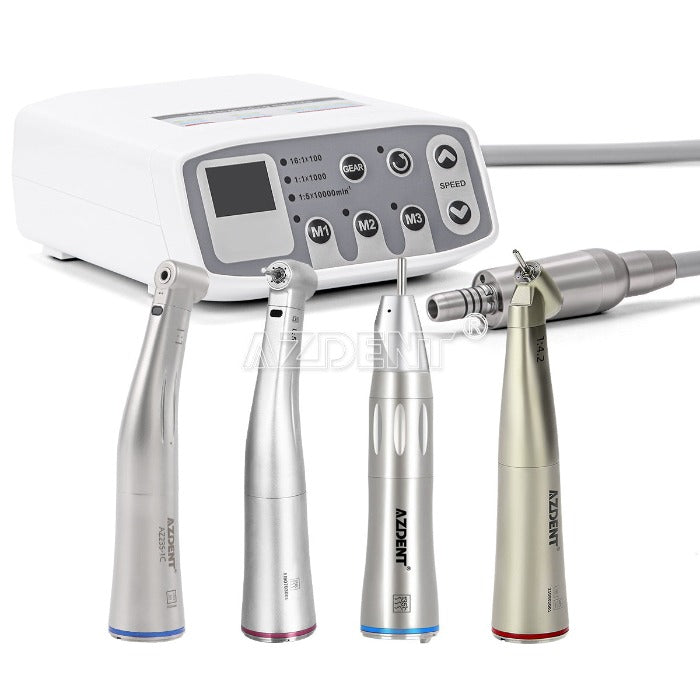
The dental electric handpiece is an essential tool in modern dentistry, transforming how dental professionals carry out procedures. Unlike traditional handpieces that utilize air pressure to operate, electric handpieces offer advanced technology and multiple benefits that enhance both the dentist’s experience and patient outcomes. This article delves into the various advantages of electric handpieces, their mechanism of action, and their application in dental practices.
The Mechanism of Electric Handpieces
Electric handpieces operate on a straightforward mechanism that relies on an electric motor rather than air pressure. The integration of an electric motor allows for more precise control over speed and torque, leading to adaptations for various dental procedures. Connecting to a power source via a cord or becoming battery-operated, electric handpieces are versatile and can be used efficiently in multiple settings.
This mechanism enables the dentist to customize the handpiece’s performance based on the requirement of the task at hand. Adjustments in speed and torque can be made effortlessly, allowing for optimized cutting or polishing, which is particularly advantageous when working on delicate materials like enamel or restorative composites.
Benefits of Dental Electric Handpieces
1. Reduced Noise Levels
One of the most immediate benefits observed with electric handpieces is the significant reduction in noise levels. Traditional air-driven handpieces can often be loud and intimidating to patients, causing anxiety and discomfort. In contrast, electric handpieces operate at a lower decibel level, which creates a more calming atmosphere in the dental office.
2. Enhanced Precision
Electric handpieces offer superior precision, allowing dentists to perform intricate procedures with remarkable accuracy. The ability to control speed means that practitioners can adjust to different materials and specific tasks more efficiently. This increased level of control reduces the risk of damage to surrounding tissues and improves overall treatment outcomes.
3. Higher Torque Preservation
Electric handpieces maintain higher torque consistently across various speeds. This is particularly important when working on tougher materials where consistent power is necessary. Unlike air-driven handpieces, which can lose torque as speed increases, electric handpieces deliver consistent results, enabling dentists to complete procedures more effectively.
4. Improved Operator Comfort
With the ergonomic design of many electric handpieces, dentists experience less strain during procedures. The reduction in hand and wrist fatigue leads to increased precision and allows for longer, more comfortable work without compromising performance or care quality. Many electric models are lightweight and designed for grip, which reduces stress on the practitioner’s hand.

5. Versatile Applications
Dental electric handpieces can be applied in a variety of dental procedures including, but not limited to, restorative dentistry, endodontics, and oral surgery. They can also be formulated with different attachments to accommodate various functions such as cleaning, polishing, or cutting. This versatility makes electric handpieces an essential tool in any modern dental practice.
Types of Electric Handpieces
Dental electric handpieces come in various formats suitable for diverse dental procedures. Here are a few types:
- Standard Electric Handpieces: These are the most commonly used types in general dentistry. They provide the functionality required for drilling and cutting.
- Micromotor Handpieces: These are typically smaller and lighter, ideal for precision work, including endodontics and intricate restorative procedures.
- Specialty Handpieces: Designed for specific applications, such as implantology or surgical procedures, these handpieces come with unique attachments to suit specialized needs.
Choosing the Right Electric Handpiece
When selecting an electric handpiece for your practice, consider several factors including:
- Speed Control: Look for handpieces with adjustable speed settings to accommodate different procedures.
- Ergonomics: Choose a handpiece that feels comfortable in hand and reduces fatigue during prolonged usage.
- Torque Stability: Ensure that the handpiece maintains consistent torque across speed settings for reliable performance.
- Weight: Lighter handpieces are generally easier to maneuver and can reduce strain on the operator.
Maintenance of Electric Handpieces
Proper maintenance is crucial to prolong the lifespan and performance of electric handpieces. Suggestions for maintenance include:
- Regular cleaning and lubrication according to the manufacturer’s guidelines.
- Routine inspection for wear and tear, replacing components as needed.
- Calibrating the handpiece regularly to ensure optimal performance.
By adhering to these maintenance practices, dental professionals can ensure their electric handpieces perform at their best and deliver high-quality patient care.
Conclusion
The dental electric handpiece has become an indispensable tool in modern dentistry, offering numerous advantages over traditional air-driven variants. With benefits such as reduced noise, enhanced precision, and operator comfort, these handpieces are poised to revolutionize the way dental procedures are performed. Investing in quality electric handpieces can lead to a more efficient practice and improved patient experiences, ultimately elevating the standard of dental care.